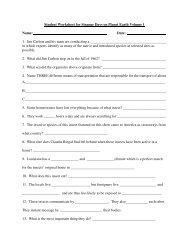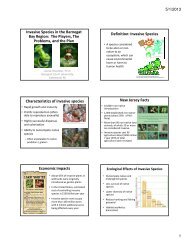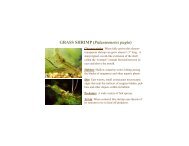Norway Maple (Acer platanoides) Japanese Barberry (Berberis ...
Norway Maple (Acer platanoides) Japanese Barberry (Berberis ...
Norway Maple (Acer platanoides) Japanese Barberry (Berberis ...
Create successful ePaper yourself
Turn your PDF publications into a flip-book with our unique Google optimized e-Paper software.
<strong>Japanese</strong> honeysuckle (Lonicera japonica)<br />
Status: Invasive.<br />
Native to: Asia.<br />
Effects: <strong>Japanese</strong> honeysuckle invades a variety of<br />
habitats including forest floors, canopies, roadsides,<br />
wetlands, and disturbed areas. It can girdle shrubs and<br />
small trees by twining around them, cutting off the flow<br />
of water through the plant. It also forms dense mats in<br />
the canopies of trees, shading everything below.<br />
https://facultystaff.richmond.edu/~jhayden/landscape_plants/late<br />
_spring_woody_plants/lonicera_japonica_UR_02s.JPG<br />
Distinctive features: <strong>Japanese</strong> honeysuckle can be<br />
distinguished from native honeysuckles by its much<br />
larger and more “showy” flowers and its large size (vines<br />
of this species can be 80 feet long and get woody with<br />
age whereas native honeysuckles grow as shrubs or<br />
short vines). In addition, its flowers form all along its<br />
branches, whereas native honeysuckles produce flowers<br />
only at the tips of their stems.<br />
Mile a Minute Vine (Polygonum perfoliatum)<br />
Status: Invasive.<br />
Native to: Eastern Asia.<br />
Effects: This plant can grow 6” per day in peak growing<br />
season, winding around other plants, and blocking light<br />
from their leaves. The weight of the vine can bend or<br />
break even relatively thick tree branches. Large<br />
infestations of mile-a-minute vine eventually reduce<br />
native plant species in natural areas.<br />
http://zipcodezoo.com/Photos/Polygonum_perfoliatum_5.jpg,<br />
http://www.hort.uconn.edu/mam/speciesID.html<br />
Distinctive features: This rapidly growing vine can grow<br />
to more than 20 feet in length. It can be distinguished<br />
from other similar vines by its distinctly triangular<br />
leaves that alternate along its long, delicate branches.<br />
It has small, sharp, curved barbs on its stems and<br />
saucer-shaped leaves at the nodes between branches.<br />
Its flowers are small, white and generally inconspicuous<br />
but the fruits that form at the ends of its branches are<br />
attractive, deep blue and are arranged in clusters.







